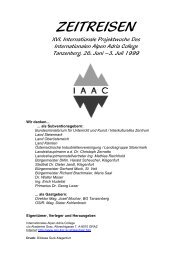Sie wollen auch ein ePaper? Erhöhen Sie die Reichweite Ihrer Titel.
YUMPU macht aus Druck-PDFs automatisch weboptimierte ePaper, die Google liebt.
cast how they will look in the future. We can only predict how it is going to be, but nature will form as the<br />
conditions in the future will be.<br />
<strong>Chaos</strong> is something that is not predictable over a long time. That happens, because a dynamic system is<br />
sensitive to initial conditions. The more unstable initial conditions a system has the more chaotic it is. You<br />
can only predict something for a short time.<br />
"In other words, it is unpredictable and yet contains regularity." ( by sci. fractals FAQ) In chaotic systems we<br />
can find examples that show us that the little differences at the beginning of a process can be multiplied during<br />
and cause big differences in the end.<br />
Examples are:<br />
The butterfly- effect: It says that if a butterfly in South Africa spreads its wings this effect can be increased<br />
that much that it can cause a tornado in Texas.<br />
The weather: There are a lot of unpredictable initial conditions that are changing all the time. Because of that<br />
you can only forecast the weather for some days.<br />
If you try to calculate chaotic events, there are always calculating mistakes. After each iteration the mistake<br />
is multiplied. In the beginning it might be very small, but after some time it leads to chaos. But still there are<br />
regions in this chaos where there is order.<br />
Another example: You have little predators and a lot of prey, the number of predators will increase. But because<br />
of that the number of prey will reduceà not enough food for the predators. Their number reduces. Now<br />
the prey have the possibility to increase their number. It is a never ending circle.<br />
Dynamical systems can be explained by linear and non- linear functions. The difference between linear and<br />
non- linear functions is how the change of the function looks. In a linear function this change is - surprise-<br />
linear. And in a non- linear function it does not have to be linear. So all that matters is how the change of the<br />
function looks.<br />
Expressing chaos through music<br />
We found out that all things in nature can be expressed also by music. You can use sequences of DNA,<br />
proteins, shapes of mountains... or you can just use algorithms to produce music. Tones can be connected<br />
to parts of the sequences or with numbers in the algorithm. If you use a sequence to produce music it has<br />
nothing to do with fractals, but if you use an algorithm you can say that you get fractal music. The principle is<br />
the same as if you show the fractal on the monitor, but you are using tones instead.<br />
19





